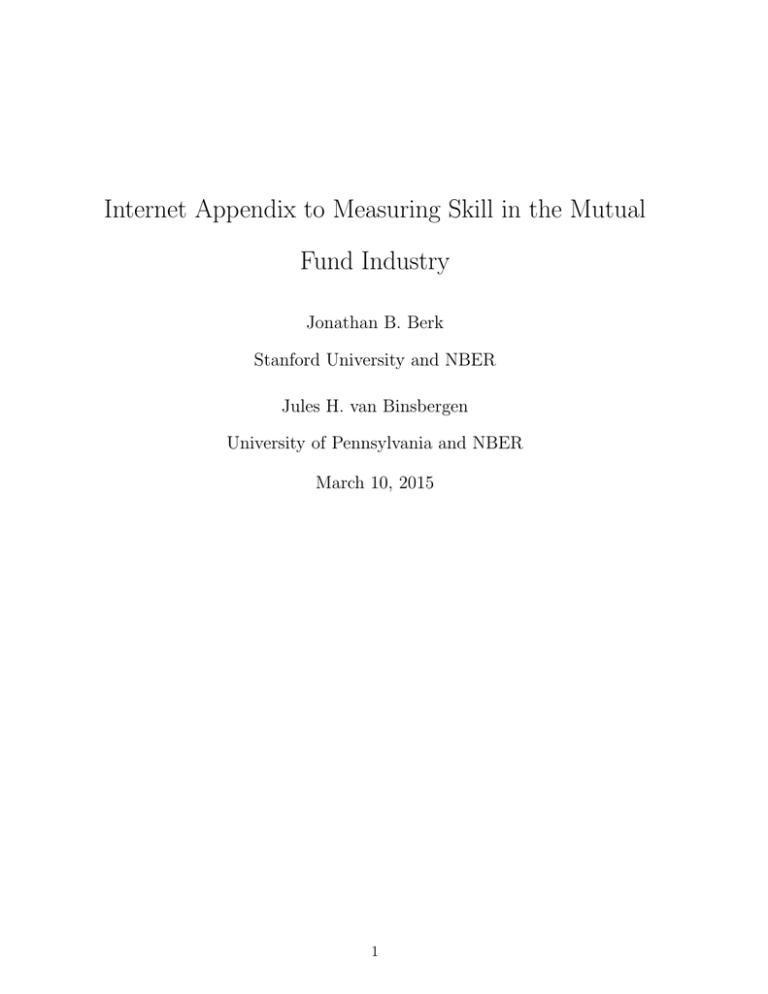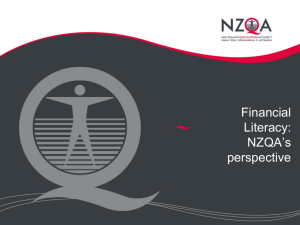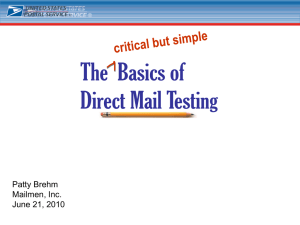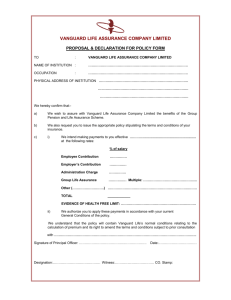Internet Appendix to Measuring Skill in the Mutual Fund Industry
advertisement

Internet Appendix to Measuring Skill in the Mutual Fund Industry Jonathan B. Berk Stanford University and NBER Jules H. van Binsbergen University of Pennsylvania and NBER March 10, 2015 1 1 Persistence without Diversification Benefits Table 1 repeats the top panel of Table 4 in the main paper using the Vanguard gross return as the benchmark rather than the Vanguard net return, that is, it shows the persistence of managerial skill without diversification benefits. Horizon Value Added Years $ Mil 3 4 5 6 7 8 9 10 0.9996 0.4903 1.7312 1.4391 2.2918 3.1794 1.6717 1.4965 p-value Top Outperforms Bottom Freq. p-value Top in Top Half Freq. p-value Panel A: Vanguard Benchmark 0.0431 0.5684 0.0347 0.5947 0.1859 0.5622 0.0387 0.5576 0.0090 0.5388 0.1184 0.5504 0.0212 0.5418 0.0923 0.5527 0.0000 0.6231 0.0000 0.6605 0.0005 0.5696 0.0187 0.5696 0.0488 0.5238 0.2339 0.5421 0.0432 0.5275 0.1814 0.5372 0.0055 0.0515 0.0597 0.0456 0.0000 0.0187 0.0915 0.1053 Fraction of Total AUM 0.2269 0.2531 0.2360 0.2292 0.2041 0.2603 0.2359 0.2437 Table 1: Out-of-sample Performance of the Top Decile without Diversification Benefits: This table repeats the top panel of Table 4 in the main paper using the Vanguard gross return as the benchmark rather than the Vanguard net return. The two columns labeled “Value Added” report the average value added of the top decile at each horizon and the associated p-value. The next two columns report the fraction of the time and associate p-value the top decile has a higher value added realization than the bottom decile. The columns labeled “Top in Top Half” report the fraction of time the realized value added of the top decile is in the top half, and the final column reports the average fraction of total AUM in the top decile. All p-values are one tailed, that is, they represent the probability, under the Null Hypothesis, of the observed test-statistic value or greater. 2 Persistence of Net Alpha Although, on average, investors do not benefit from managerial skill, as we document in the main text, investors are able to identify better managers ex-ante. So a natural question to ask is whether or not investors benefit when they use this information. That is, would an investor who identified a skilled manager have expected a positive net alpha? To investigate this possibility, we calculate the average net alpha of investing in the outof-sample sorts. That is, in each skill ratio decile, for each fund and at each point in time, we calculate the net abnormal return, εit = Ritn − RitB over measurement horizons of three to 10 years. As before, we drop the first m observations in the measurement horizon, where m = 18 or 6 months for the Vanguard Benchmark and the FFC factor specification, respectively. We then compute, at each point in time, the weighted average net abnormal return of each decile. At the end of the process, in each decile, we have a time series of monthly estimates for the weighted average net alpha of each decile. This time series corresponds to the abnormal return of an extra marginal dollar invested in a value weighted portfolio of funds in the decile in each month. To get the average net alpha of this strategy, we compute the mean of this time series and its standard error. Figure 1 plots this mean as well as the two standard error bounds for each decile and time horizon. Consistent with the Alternative hypothesis, almost all net alpha estimates are not statistically significantly different from zero. As we show in Table 2, the point estimates of the tenth decile are very close to zero and mostly negative. The order statistics in Table 2 confirm the overall impression from Figure 1 that there is weak evidence of predictability in net alpha. Of the 16 order statistics, 7 of them have a one tailed p-value below 5% and only two are below 1%. So, at best, there is weak evidence that by picking the best managers, investors can get better returns than by picking the worst managers. The evidence appears more consistent with the idea that competition in capital markets drives net alphas close to zero. In this case, there is a striking difference when we use the FFC factor specification as a risk adjustment. There is strong, statistically significant evidence of relative performance differences across the deciles (all but 3 of the order statistics are below 1% in this case). 3 Panel A: Vanguard Benchmark 3 Years 4 Years 5 Years 6 Years 10 10 10 10 5 5 5 5 0 0 0 0 −5 −5 −5 −5 −10 −10 −10 −10 −15 −15 −15 −15 −20 −20 1 2 3 4 5 6 7 8 9 10 −20 1 2 3 4 5 6 7 8 9 10 7 Years −20 1 2 3 4 5 6 7 8 9 10 8 Years 1 2 3 4 5 6 7 8 9 10 9 Years 10 Years 10 10 10 10 5 5 5 5 0 0 0 0 −5 −5 −5 −5 −10 −10 −10 −10 −15 −15 −15 −15 −20 −20 1 2 3 4 5 6 7 8 9 10 −20 1 2 3 4 5 6 7 8 9 10 −20 1 2 3 4 5 6 7 8 9 10 1 2 3 4 5 6 7 8 9 10 Panel B: FFC Risk Adjustment 3 Years 4 Years 5 Years 6 Years 10 10 10 10 5 5 5 5 0 0 0 0 −5 −5 −5 −5 −10 −10 −10 −10 −15 −15 −15 −15 −20 −20 1 2 3 4 5 6 7 8 9 10 −20 1 2 3 4 5 6 7 8 9 10 7 Years −20 1 2 3 4 5 6 7 8 9 10 8 Years 1 2 3 4 5 6 7 8 9 10 9 Years 10 Years 10 10 10 10 5 5 5 5 0 0 0 0 −5 −5 −5 −5 −10 −10 −10 −10 −15 −15 −15 −15 −20 −20 −20 1 2 3 4 5 6 7 8 9 10 1 2 3 4 5 6 7 8 9 10 −20 1 2 3 4 5 6 7 8 9 10 1 2 3 4 5 6 7 8 9 10 Figure 1: Out-of-Sample Net Alpha Each graph displays the out-of-sample performance (in b.p./month) of funds sorted into deciles on the Skill Ratio, Ŝi , over the horizon indicated. The solid line indicates the performance of each decile and the dashed lines indicated the 95% confidence bands (two standard errors from the estimate). Panel A shows the results when net alpha is computed using Vanguard index funds as benchmark portfolios, and Panel B shows the results using he FFC risk adjustment. 4 Horizon Years Net Alpha b.p. t-stat. Top Outperforms Bottom Freq. (%) p-value (%) Top in Top Half Freq. (%) p-value (%) 3 4 5 6 7 8 9 10 0 -3 -1 -2 3 -1 -1 -1 0.06 -0.95 -0.11 -0.43 0.99 -0.29 -0.46 -0.24 Panel A: Vanguard Benchmark 54.21 13.82 55.76 5.15 52.33 24.68 54.91 5.84 58.58 0.29 53.17 18.16 53.11 16.64 47.90 78.71 58.42 57.14 52.33 55.27 60.08 56.54 56.41 52.10 1.21 2.07 24.68 4.56 0.06 2.56 1.97 24.74 3 4 5 6 7 8 9 10 2 1 3 3 3 3 3 3 0.76 0.47 1.11 1.02 1.04 0.88 0.96 1.10 Panel B: FCC Risk Adjustment 59.14 0.00 54.97 1.72 60.40 0.00 58.21 0.02 56.12 0.44 59.34 0.00 57.28 0.05 56.09 0.51 60.43 57.72 59.19 57.78 56.12 57.36 54.95 55.44 0.00 0.05 0.00 0.04 0.44 0.10 1.37 1.11 Table 2: Out-of-sample Net Alpha of the Top Decile: The columns labeled “Net-Alpha” report the weighted average net alpha (in b.p./month) of the top decile at each horizon and the associated p-value. The next two columns report the fraction of the time and associate p-value the top decile has a net alpha realization greater than the bottom decile. The columns labeled “Top in Top Half” report the fraction of time the realized net alpha of the top decile is in the top half. All p-values are one tailed, that is, they represent the probability, under the Null Hypothesis, of the observed test-statistic value or greater. 3 The Effect of Restricting Attention to Funds Exclusively Investing in the U.S. The existence of numerous selection biases that have influenced the inferences of prior mutual fund studies is well known.1 Consequently, we have been careful to make sure that this study is free of such biases. We therefore use the full set of actively managed mutual funds available to a U.S. investor at the time. In this section we investigate the extent to which our estimates are affected by the selection bias induced by restricting the dataset to funds that invest exclusively in the U.S. 1 See, for example, ?. 5 All Equity U.S. Equity Only Panel A: Vanguard Benchmark In Sample VA Mean ($mil/mon) 0.14** Weighted Mean ($mil/mon) 0.27** -0.01 -0.00 Persistence (p-value (%) of top decile outperforming bottom) 3 year horizon 4.75 0.23 4 year horizon 2.07 17.10 5 year horizon 3.54 75.32 6 year horizon 1.09 3.51 7 year horizon 0.01 0.02 8 year horizon 0.67 0.46 9 year horizon 9.15 1.46 10 year horizon 5.55 91.40 In Sample Net Alpha Equally Weighted (b.p./mon) Value Weighted (b.p./mon) Total Number of Funds 3 -1 -1 -5 5974 2731 Panel B: FCC Risk Adjustment In Sample VA Mean ($mil/mon) 0.10** Weighted Mean ($mil/mon) 0.25** -0.07 -0.05 Persistence (p-value (%) of top decile outperforming bottom) 3 year horizon 0.47 0.11 4 year horizon 0.02 0.00 5 year horizon 0.00 0.45 6 year horizon 0.01 0.00 7 year horizon 0.00 0.08 8 year horizon 0.01 3.03 9 year horizon 0.18 1.09 10 year horizon 0.01 24.22 In Sample Net Alpha Equally Weighted (b.p./mon) Value Weighted (b.p./mon) -4 -6** -7** -8** Total Number of Funds 6054 2811 Table 3: International Investing Analysis: The table shows the results of our main tests in the subsample that only includes funds that only invest in U.S. stocks. * – tstatistic greater (in absolute value) than 1.96. **– t-statistic greater (in absolute value) than 2.54. Even when we consider active funds that invest in U.S. equity only, we always use all 11 Vanguard index funds at the benchmark. 6 Table 3 shows that excluding international funds neither affects our persistence results (past value added predicts future value added) nor does it affect our results regarding returns to investors: net alphas are not significantly different from zero when managers are evaluated against the tradable benchmark. However, it does affect our average value added results. The average manager who voluntarily restricts herself to only invest in U.S. stocks does not add value. To investigate this further, in Table 4 we form subsamples of active and index funds based on their ex post average portfolio weight in international stocks. We find that active funds that invested more in international stocks added more value. Funds that restricted themselves to investing less than 10% of their AUM in nonU.S. stocks added no value on average. Active Funds Frac. int. <10 <30 <50 <70 <90 ≤ 100 No of funds 3740 4617 4817 5002 5236 5974 Vanguard BM Net Mean VA Mean VA TW 0 0.013 0.055 0.126 0.074 0.159 0.106 0.219 0.133 0.266 0.135 0.269 Vanguard BM Gross Mean VA Mean VA TW -0.045 -0.073 -0.002 0.025 0.016 0.056 0.045 0.113 0.073 0.158 0.072 0.162 Vanguard BM Net Mean VA Mean VA TW 0.102 0.175 0.094 0.167 0.123 0.178 0.121 0.177 0.070 0.163 0.034 0.114 Vanguard BM Gross Mean VA Mean VA TW 0.034 0.032 0.028 0.021 0.042 0.056 0.041 0.051 0.026 -0.003 -0.025 -0.046 Index Funds Frac. int. <10 <30 <50 <70 <90 ≤ 100 No of funds 462 485 494 509 521 644 Table 4: Fraction in International Funds and the Performance of Active Funds vs Index Funds: The table computes value added numbers for funds with varying degrees of international stock exposure. We compute the numbers for active as well as passive funds. We use two different benchmarks: (1) Vanguard index funds net returns and (2) Vanguard index funds gross returns. ”Mean VA” is the ex ante mean, and ”Mean VA TW” is the ex-post mean. One potential concern is that our Vanguard benchmark funds do not appropriately 7 define the alternative investment opportunity set for international stocks, even though we include all the international index funds that Vanguard offers. If this explanation is right, it implies that index funds that invest more internationally should also add more value. Table 4 shows that this is not the case. We find that index funds that invested more in international stocks added less value. Therefore, the ex post selection of active funds that have invested more or less in international funds appears to be correlated with skill, perhaps due to the fact that over the sample period the fraction of retail investors has declined significantly in the U.S., but less so internationally. Because it is unclear how investors could have predicted this fact, we use the full cross-section of mutual funds traded in the U.S. in this study. 8





